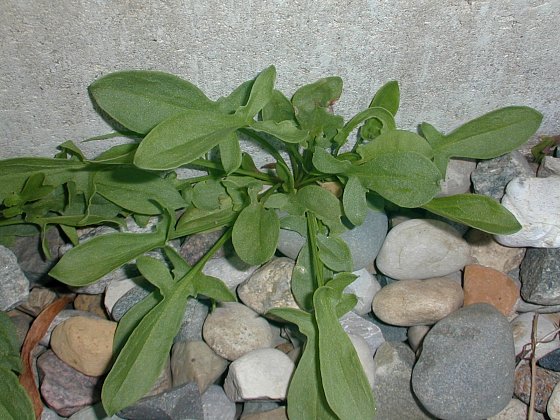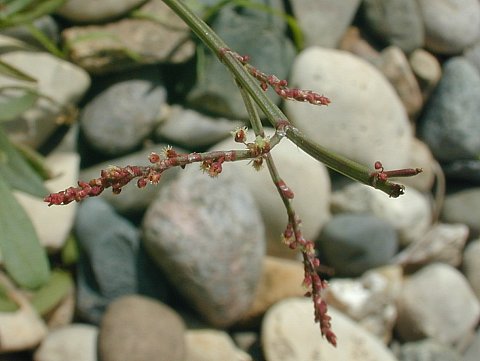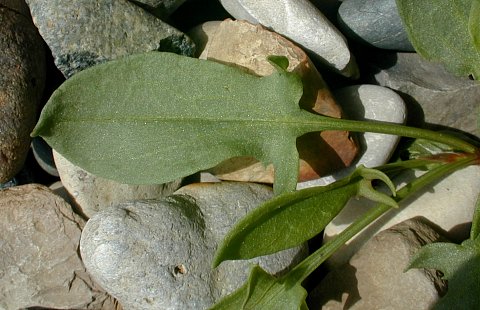Description: This herbaceous perennial plant consists of a rosette of basal leaves, from which occasional flowering stalks are produced. The rosette of basal leaves typically spans about 4-6" across, while the flowering stalks are about ¾–1½' tall and more or less erect. A full-sized basal leaf is about 3" long and 1" across (including the petiole, which is about as long as the leaf blade). It is hastate in shape (i.e., arrowhead-shaped, but with spreading basal lobes), hairless, and smooth along the margins. The leaf is usually broadest above the middle, while the small basal lobes are often rounded, rather than pointed. The slender flowering stalks are angular or ridged, terminating in a panicle with spike-like racemes of tiny flowers. The few leaves that occur on these stalks are alternate, lanceolate or linear, sessile, and greatly reduced in size.

Because Sheep
Sorrel is a dioecious species, the flowers of a plant are either
all-male or all-female. Each flower is about 1/12" (2 mm.) across and
consists
of 6 sepals and no petals. A male flower has 6 stamens, while a female
flower has a pistil with a white tripartite style. Each division of the
style is itself divided into long narrow lobes and has a frilly
appearance. The sepals are initially green, but become red or reddish
brown while the flowers are in bloom and the achenes ripen. The 3 inner
sepals do not develop membranous wings as they mature, unlike other
Sorrel species. The achene of a female flower is reddish to yellowish
brown and 3-angled, tapering to a point at both ends. Its surface is
more granular than shiny. The surrounding sepals are about the same
length as the achene, but they do not fully enclosed it. The root
system consists of a taproot that is shallow and slender, and long
rhizomes that snake out in all directions. This plant often forms
vegetative colonies.
Cultivation:
Sheep Sorrel is usually found in full or partial sunlight, mesic to dry
conditions, and a poor acid soil that is either sandy or gravelly
(although not limestone). It can also flourish in rich loam or
clay-loam soil at highly disturbed sites. This plant is quite
aggressive and difficult to eradicate.

Range &
Habitat:
The non-native Sheep Sorrel is a common plant that occurs in every
county of Illinois
(see Distribution
Map). Habitats include sand prairies, sandy paths, chert and
granite
glades, abandoned fields, areas along railroads, gardens and lawns,
gravel beds along buildings and around shrubs, and dry sunny waste
areas. Sheep Sorrel has the capacity to invade disturbed areas of some
natural habitats, especially sandy ones. It is adventive from Europe.
Faunal Associations:
The flowers are wind-pollinated and attract few insect visitors. The
leaves are a preferred source of food for the caterpillars of the
American Copper (Lycaena
phlaeas americana), which may be an indication that this butterfly is
an introduction
from Europe. Other insects that feed on the foliage and other parts of
Sheep Sorrel (Rumex acetosella) include the Brazzy Flea Beetle
(Chaetocnema concinna), other flea beetles (Mantura spp.), larvae of a
weevil (Rhinoncus castor), an aphid (Brachycaudus rumexicolens),
Trochanter Mealybug (Pseudococcus sorghiellus), Mottled Sand
Grasshopper (Sparagemon collare) and other grasshoppers, Protean
Shieldback (Atlanticus testaceus), and Straight-lanced Meadow Katydid
(Conocephalus strictus); see Clark et al. (2004), Majka et al. (2007),
Blackman & Eastop (2013), ScaleNet website (2014), Bouseman &
Sternburg (2001), and Gangwere (1961, 1967). Some songbirds and upland
gamebirds eat the seeds of Sheep Sorrel – these species include the
Henslow's Sparrow, Grasshopper Sparrow, Field Sparrow, American Tree
Sparrow, Brown-headed Cowbird, Ruffed Grouse, and Wild Turkey (Martin
et al., 1951/1961; Bennetts, 1900; Meanley, 1956). The latter two bird
species also feed on the leaves. Among mammals, the Meadow Jumping
Mouse eats the seeds of Sheep Sorrel, while the Cottontail Rabbit and
Woodland Vole feed on the foliage (Martin et al., 1951/1961; Whitaker
& Mumford, 1970). The Wood Turtle (Glyptemys insculpta) also eats
the leaves of this plant (Lagler, 1943).
Photographic Location:
The plants were growing in or near a gravel bed along the apartment
building of the webmaster in Urbana, Illinois.

Comments: Other common names for this species are Red Sorrel, Field Sorrel, and Common Sorrel. Sometimes the leaves are added in small amounts to salads and other culinary dishes to provide a sour taste. However, they contain significant amounts of oxalic acid, which can be toxic to the kidneys if a sufficiently large quantity of leaves is eaten. Sheep Sorrel closely resembles in appearance its native counterpart, Rumex hastulatus (Wild Sorrel). Wild Sorrel occurs in only two counties in SW Illinois and is state-listed as endangered. It differs from Sheep Sorrel primarily by its inner sepals – they become winged and heart-shaped with maturity, fully enclosing each achene. The root system of Wild Sorrel consists of a taproot; it may form clumps of plants through short rootstocks, but doesn't create new plants from long spreading rhizomes. Another species that is rarely encountered in the wild is Rumex acetosa (Garden Sorrel). This introduced species is a bigger plant than Sheep Sorrel. Garden Sorrel has sagittate leaves (with basal lobes that are downward pointing, rather than spreading), and its cauline leaves clasp the flowering stalks.